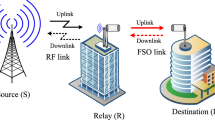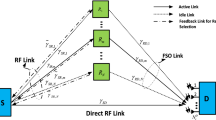Abstract
We present novel closed-form expressions for the outage probability of the amplify-and-forward dual-hop semi-blind relaying channel, composed of mixed radio frequency (RF)/free space optical (FSO) links, while the relay is corrupted by both co-channel interferences and noise. The RF link is assumed to follow Nakagami-m distribution, while the FSO link is under the influence of atmospheric turbulence modelled by the Gamma–Gamma fading taking pointing errors into account. The analytical results are validated by Monte Carlo simulations. The obtained general expressions are simplified when RF link is noise-limited. The numerical results show the existence of the outage probability floor, which can be taken into account in the system design.






Similar content being viewed by others
References
Lee, E., Park, J., Han, D., & Yoon, G. (2011). Performance analysis of the asymmetric dual-hop relay transmission with mixed RF/FSO links. IEEE Photonics Technology Letters, 23(21), 1642–1644.
Ansari, I. S., Yilmaz, F. Y., & Alouini, M.-S. (2013). Impact of pointing errors on the performance of mixed RF/FSO dual-hop transmission systems. IEEE Wireless Communications Letters, 2(3), 351–354.
Samimi, H., & Uysal, M. (2013). End-to-end performance of mixed RF/FSO transmission systems. IEEE Journal of Optical Communications and Networking, 5(11), 1139–1144.
Popoola, W. O., Ghassemlooy, Z., Allen, J. I. H., Leitgeb, E., & Gao, S. (2008). Free-space optical communication employing subcarrier modulation and spatial diversity in atmospheric turbulence channel. IET Optoelectronics, 2(1), 16–23.
Samimi, H., & Azmi, P. S. (2011). Performance analysis of adaptive subcarrier intensity-modulated free-space optical systems. IET Optoelectronics, 5(4), 168–174.
Popoola, W. O., & Ghassemlooy, Z. (2009). BPSK subcarrier intensity modulated free-space optical communications in atmospheric turbulence. Journal of Lightwave Technology, 27(8), 967–973.
Simon, M. K., & Alouni, M.-S. (2004). Digital communication over fading channels (2nd ed.). New York: Wiley.
Ghassemlooy, Z., & Popoola, W. O. (2013). Optical wireless communications: System and channel modelling with MATLAB. New York: CRC Press.
Andrews, L. C., & Philips, R. N. (2005). Laser beam propagation through random media (2nd ed.). Bellingham: Washington:Spie Press.
Al-Habash, M. A., Andrews, L. C., & Philips, R. N. (2011). Mathematical model for the irradiance probability density function of a laser beam propagating through turbulent media. Optical Engineering, 40(8), 1554–1562.
Nistazakis, H. E., Tsiftsis, T. A., & Tombras, G. S. (2009). Performance analysis of free-space optical communication systems over atmospheric turbulence channels. IET Communications, 3(8), 402–1409.
Farid, A. A., & Hranilovic, S. (2007). Outage capacity optimization for free space optical links with pointing errors. Journal of Lightwave Technology, 25(7), 1702–1710.
Farid, A. A., & Hranilovic, S. (2011). Outage capacity for MISO intensity-modulated free-space optical links with misalignment. IEEE Journal of Optical Communications and Networking, 3(10), 780–789.
Sandalidis, H. G., Tsiftsis, T. A., & Karagiannidis, G. K. (2009). Optical wireless communications with heterodyne detection over turbulence channels with pointing errors. Journal of Lightwave Technology, 27(20), 4440–4445.
Gappmair, W. (2011). Further results on the capacity of free-space optical channels in turbulent atmosphere. IET Communications, 5(9), 1262–1267.
Hasna, M. O., Alouini, M.-S., Bastami, A., & Ebbini, E. S. (2003). Performance analysis of cellular mobile systems with successive co-channel interference cancellation. IEEE Transactions on Wireless Communications, 2(1), 29–40.
Alouini, M.-S., & Goldsmith, A. J. (1999). Area spectral efficiency of cellular mobile radio systems. IEEE Transactions on Vehicular Communications, 48(4), 1047–1066.
Xu, F., Khalighi, M.-A., & Bourennane, (2011). Impact of different noise sources on the performance of PIN- and APD-based FSO receivers. In 11th international conference on telecommunications (ConTEL 2011) (pp. 211–218), Graz, Austria.
Suraweera, H. A., Michalopoulos, D. S., Schober, R., Karagiannidis, G. K., & Nallanathan, A. (2011). Fixed gain amplify-and-forward relaying with co-channel interference. IEEE International Conference on Communications (ICC), 2011, 1–6.
Xia, M., Xing, C., Wu, Y. C., & Assa, S. (2011). Exact performance analysis of dual-hop semi-blind AF relaying over arbitrary Nakagami-m fading channels. IEEE Transactions on Wireless Communications, 10(10), 3449–3459.
Gradshteyn, I. S., & Ryzhik, I. M. (2000). Table of integrals, series, and products (6th ed.). New York: Academic.
The Wolfarm Functions Site. (2008). (Online) Available: http://functions.wolfarm.com
Luong, D. A., Thang, T. C., & Pham, A. T. (2013). Effect of avalanche photodiode and thermal noises on the performance of binary phase-shift keying-subcarrier-intensity modulation/free-space optical systems over turbulence channels. IET Communications, 7(6), 738–744.
Author information
Authors and Affiliations
Corresponding author
Additional information
This work was supported by European Science Foundation under COST IC1101 OPTICWISE Action “Optical Wireless Communications—An Emerging Technology”, Ministry of Education, Science and Technology Development of Republic of Serbia under grants TR-32028 and III-44006.
Rights and permissions
About this article
Cite this article
Petkovic, M.I., Cvetkovic, A.M., Djordjevic, G.T. et al. Outage Performance of the Mixed RF/FSO Relaying Channel in the Presence of Interference. Wireless Pers Commun 96, 2999–3014 (2017). https://doi.org/10.1007/s11277-017-4336-7
Published:
Issue Date:
DOI: https://doi.org/10.1007/s11277-017-4336-7




